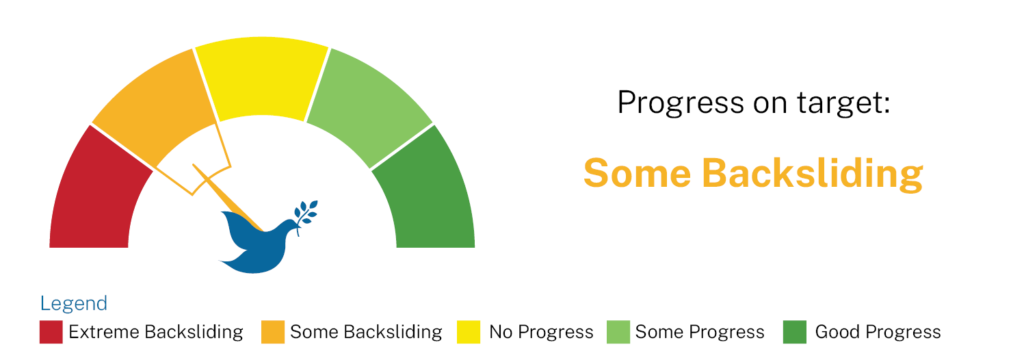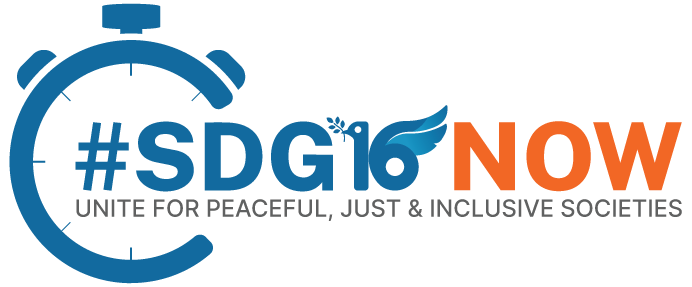Target 16.3: Promote the rule of law at the national and international levels and ensure equal access to justice for all

Official data is limited, and that which is available shows no progress or backsliding. Rates of reporting sexual assault remain low, while since 2015, the global proportion of unsentenced detainees has slightly increased. Data from civil society organisations shows worsening situations across the world on the rule of law, access to justice and legal aid. Furthermore, financial, logistical, and security constraints impede the work of grassroots justice defenders and legal aid actors, particularly given the challenging context of increasing authoritarianism and the closure of civic space. Target 16.3 is closely linked with the entire SDG Agenda, and the lack of sustained progress on advancing the rule of law and access to justice does not bode well for the achievement of the 2030 Agenda.
Authors of chapter




Context and Interlinkages
The United Nations Secretary-General has described the rule of law as a “principle of governance in which all persons, institutions and entities, public and private, including the State itself, are accountable to laws that are publicly promulgated, equally enforced and independently adjudicated, and which are consistent with international human rights norms and standards.”1 The rule of law promotes equality, fairness and accountability, as well as participation and transparency.
While there is no single definition for access to justice, there is agreement that it is broadly concerned with “the ability of people to defend and enforce their rights and obtain just resolution of justiciable problems in compliance with human rights standards; if necessary, through impartial formal or informal institutions of justice and with appropriate legal support.”2 It is equally integral to achieving the Sustainable Development Goals (SDGs) and inclusive growth. “An estimated four billion people around the world live outside the protection of the law, mostly because they are poor or marginalised within their societies. They can be easily cheated by employers, driven from their land, preyed upon by the powerful, and intimidated by violence.”3 Moreover, every day, millions of poor and marginalised persons around the world entangled in criminal justice systems face arbitrary and extended pretrial detention, torture, coerced confessions, discrimination, wrongful convictions, stigma, health and livelihood impacts, and other abuses. Lack of justice, including inadequate legal protections and the inability to fairly resolve grievances, is a major reason why people fall into, and remain in, extreme poverty.
Through the rule of law and access to justice, individuals and communities are able to fully participate in society, engage with development processes, and enforce their rights.4 Legal aid and legal empowerment are critical tools to enable individuals and communities to achieve justice, to ensure that justice systems function fairly and effectively, and to foster good governance and responsive institutions.5 There is ample evidence demonstrating that rule of law and access to justice are necessary preconditions for achieving and sustaining every other Sustainable Development Goal, particularly ending poverty (Goal 1), achieving gender equality (Goal 5), reducing inequality (Goal 10), ensuring health and well-being (Goal 3), and protecting the environment (Goals 13, 14, 15).6 They are also linked across a variety of SDG16+ targets, including overlapping with Target 5.2 on reducing violence against women and girls, fundamental freedoms (16.10), and reducing corruption (16.5). National Human Rights Institutions (NHRIs) and Supreme Audit Agencies (16.a) can be powerful bodies to promote them.
Progress on Indicators
Official Indicators:
- 16.3.1: Proportion of victims of violence in the previous 12 months who reported their victimisation to competent authorities or other officially recognized conflict resolution mechanisms (Tier II)
- 16.3.2: Unsentenced detainees as a proportion of overall prison population (Tier I)
- 16.3.3: Proportion of the population who have experienced a dispute in the past two years and who accessed a formal or informal dispute-resolution mechanism, by type of mechanism. (Tier II)
Additional Indicators:
- World Justice Project Rule of Law Index
- Global Insights on Access to Justice, World Justice Project (2019)
- Measuring the Justice Gap, World Justice Project (2019)
- Grassroots Justice Network (formerly the Legal Empowerment Network) Annual Member Surveys
- 2016 UNODC/UNDP Global Study on Legal Aid
The availability of data related to Target 16.3 varies by indicator. Data on official indicators suggests that progress is, at best, stagnant, and at worst, backsliding.
There is limited official data on 16.3.1. Only 50 countries have reported data on Indicator 16.3.1 (robbery) via the SDG Database, and even fewer for Indicator 16.3.1 on physical violence and sexual assault. Crime-reporting rates have increased in some countries while decreasing in others.7 What little information is available on the reporting of sexual assault shows the reported level is only around 30 per cent in countries with the highest level of reporting. At the same time, in 2022, the official data for the related SDG16+ Indicator 16.5.2 describes violence against women and girls as “prevalent across countries and affects women of all ages.”
The UN Statistics SDG Database has official data for Indicator 16.3.2 from 192 countries that have reported it at least once since 2001. According to the UNSG, 30 per cent of the global prison population – 3.4 million people – were unsentenced prisoners in 2021. Data on Indicator 16.3.2 suggests that since 2015, the global proportion of unsentenced detainees has slightly increased. The UN Secretary-General described it as “far from the target of equal access to justice for all.” 8
Presently, only 5 countries have reported data on Indicator 16.3.3. Given that Indicator 16.3.3 was only established in 2020, the lack of available, comparable, historical data makes it difficult to assess progress over time.
Additional Indicators
The official indicators for SDG 16.3 do not comprehensively measure the broad and multidimensional concepts of rule of law or equal access to justice for all.9 For example, they fail to measure justice outcomes, or people’s perceptions about the fairness of justice processes and outcomes. The indicators do not track adherence to internationally recognised fair trial rights, such as the right to be heard by an independent and impartial tribunal, or the right to legal assistance.10 The scarcity of data submitted through the Voluntary National Review (VNR) process, combined with a lack of disaggregated official data from the UN and other international sources, has made it difficult to measure progress towards Target 16.3 since the adoption of the 2030 Agenda.11
Given the shortcomings of the official indicators as noted above, it is critical to look to alternative indicators and sources to measure progress towards Target 16.3. The WJP Rule of Law Index 2022 finds that the rule of law has been declining globally for five consecutive years.12 Analysis of the World Justice Project’s (WJP’s) legal needs survey data from 101 countries found that only 17 per cent of those who experienced a legal problem turned to an authority or third party to resolve the dispute.13 An estimated 1.5 billion people “cannot obtain justice for civil, administrative, or criminal justice problems.”14 Available data also makes clear that there is a severe global crisis in access to legal aid. A 2016 UNODC/UNDP Global Study on Legal Aid found that although many countries recognise the right to legal aid in criminal cases, in practice, many poor and vulnerable accused persons are unable to exercise this right in any meaningful way. Importantly, the study also noted the limited availability of reliable data on legal aid in responding countries.15 Subsequently, UNODC began collecting official data from countries on access to legal representation (including legal aid services) in criminal cases. Unfortunately, between 2015 and 2020, only 10 countries have reported any data, and only two of these countries have provided comprehensive data.16
The indicators also fail to measure access to holistic forms of legal assistance, including through grassroots actors who help communities know, use, and shape the laws and policies that affect their fundamental human rights. Information from civil society groups engaging in legal empowerment efforts at the grassroots level also indicate a growing gap in access to civil legal aid. The 2021 annual membership survey of the Grassroots Justice Network (formerly the Legal Empowerment Network) – the world’s largest community of grassroots justice defenders, representing members from over 3,300 organisations – reveals troubling trends. In 2021, 45 per cent of respondents said their funding situation had worsened, with 78 per cent having to make cuts or unable to operate due to lack of funds. Overall, historical results show that financial struggles for grassroots justice groups have increased since 2018. Furthermore, 50 per cent of respondents stated that members of their organisations or communities had been threatened, arrested, or harassed while pursuing justice in the past year – an increase from 42 per cent in 2019.17 In an era of rising authoritarianism, governments are increasingly erecting legal and political barriers to civil society activity, restricting access to funding, and fostering mistrust against justice defenders. In many contexts, these challenges impair the ability of grassroots organisations to sustain and safely provide programmes and services that ensure access to justice for communities.
Case studies
Case Study: Kituo Cha Sheria, Kenya
Better access to justice can offer a pathway for communities to address the causes and consequences of climate change. In Kenya, Pokot and Tugen communities living on Lake Baringo’s shores are extremely vulnerable to the effects of climate change due to rising water levels. The communities have experienced increased malaria infections, crop destruction, and population displacement. Community members invited legal empowerment organisation Kituo Cha Sheria to conduct a fact-finding mission, following which they jointly filed a petition in an Environment and Land Court in Iten, Kenya to hold the Kenyan government accountable for failing to adhere to their obligations under the national Climate Change Act and address the community’s basic needs. This case, which is pending, is the first of its kind in the East and Horn of Africa.
Case Study: Public Defender Society of Nepal (PDS-Nepal)
Barriers to access to justice create cycles of poverty and deepen inequality. Across Nepal, courts routinely impose fines as a punishment for petty offences. Those who cannot pay are forced to “pay off” their fines in jail time. In March 2021, PDS-Nepal lawyers met a teenage boy who had been convicted of a petty theft offence and ordered to pay USD 3,000 and serve 30 days in prison. Three-years later, he was still in prison, working off the fine. PDS-Nepal provided him with legal representation, secured his release, and launched a campaign to end fines and fees for children. The Supreme Court recognised the merit of the argument and invited PDS-Nepal to argue the issue to the Constitutional Bench challenging the law as discriminatory.
Recommendations
For the international community (Member States, multilateral actors, and grant-making institutions):
- Increase sustainable and flexible funding for grassroots actors on the frontlines of justice challenges, including civil society groups engaging in legal aid and legal empowerment efforts.
- Promote learning and data sharing among governments, multilateral actors, civil society, and affected communities around critical justice challenges and people-centred approaches to resolving them.
For Member States:
- Promote and invest in people-centred approaches to create justice systems that are more responsive to people’s justice needs.18
- Work together with civil society to address the most pressing issues in criminal justice, including but not limited to: excessive pretrial detention, mass incarceration, discrimination including racial injustice, access to quality legal aid, and the criminalisation of poverty and status.
- Engage civil society in planning and budgeting conversations on access to justice and the SDGs.
- Strengthen protections for grassroots justice defenders from all threats and violence.
To improve data collection, we suggest that:
- The UN and Member States invest in collecting, disaggregating, and utilising data for both official and alternative indicators for Target 16.3.
- Member States should regularly and meaningfully report on SDG 16.3 through their VNRs and acknowledge any challenges.
- UN agencies should be resourced to better track the official and other meaningful alternative indicators.
- Civil society should be supported, through financing and partnerships, to share their data and develop and submit reports that not only fill the gaps in official data but can also help to hold national governments accountable to their commitments and claims.

Resources
- World Justice Project: Atlas of Legal Needs Surveys
- World Justice Project: Rule of Law Index 2022
- World Justice Project and Pathfinders: Grasping the Justice Gap
- SDG 16 Data Initiative: Are we on track to meeting the 2030 Agenda?
- UN principles and Guidelines on Access to Legal Aid in Criminal Justice Systems
- The International Legal Foundation: Global Study on Legal Aid
- The International Legal Foundation: Measuring Justice
- Namati: Justice For All. The Case to Fund and Protect Grassroots Justice Defenders
- Namati: Grassroots Justice in a Pandemic: Ensuring a Just Response and Recovery
- Pathfinders: Justice for all: Report of the Task Force on Justice
- Praia Group on Governance Statistics: Handbook on Governance Statistics
